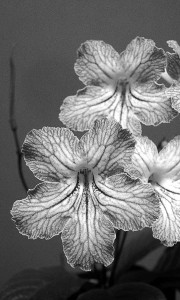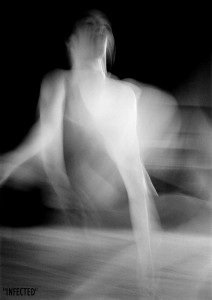With a glass of white wine in one hand and a hunk of bread topped with a quivering dollop of hummus in the other, several gallery patrons including myself stood with headphones on, watching an endoscopic video installation exploring what looked to be freshly excavated tunnels within a pot of Rose’s Lime Marmalade.

The Tissue Culture & Art Project: Oron Catts & Ionat Zurr in collaboration with Stelarc: Semi-Living Extra Ear 1/4 scale
The piece is called Glack, created by Adam Zaretsky and Tanja Visosevic. Glack is a visual and metaphysical tour into the DNA slop buckets swilling beneath our skins, that uncertain visceral ‘stuff’ that secretes into bodily taboos, evading the clean taxonomy of scientific visualisation. Positioned at the main entrance to the Experimental Art foundation gallery, Glack is the gooey gateway to Art of the Biotech Era, an exhibition, curated by EAF Director Melentie Pandilovski examining the interrelationship between aesthetics, ethics and biotechnology.
Science is primarily a system for acquiring knowledge, for which there are infinite arrays of mediums. Engaging critically with Transgenic Art, artists utilising genetic material as a medium, is a difficult matter. Muddying up the boundaries between aesthetics and careful scientific enquiry, the works of artists and science collaborators such as Eduardo Kac, Andre Brodyk, Stelarc and the Tissue Culture and Art Project present unstable ground for ethical debate on the relationship between nature and design.

George Gessert: The Family of 'Mark Tobey' from Origin
From Eduardo Kac, the man who brought us Alba, a rabbit that glows in the dark, comes the synthesis of an ‘artist gene’, in a work titled Genesis. The artist-gene sequence was arrived at by translating a passage from the bible into Morse and then genetic code. Audiences can choose to interact with the synthetic gene, which has been planted amidst several types of bacteria, by exposing it to bursts of measured UV radiation, accessible via a computer screen interface connected to the light source. Each interaction results in a series of possible mutations that cause the bacteria to hold, share or lose their colourings.
Ever-questioning the assumed nature of the human body, Stelarc, in conjunction with the Tissue Culture and Art Project, exhibits a work in progress of Semi-Living Extra Ear ¼ 1/4 Scale, a video projection and installation of living human cells. Churning around in a micro-gravity bioreactor is a living approximation of Stelarc’s ear, generated from human cells, presumably those of the artist. The potential outcome of the project – that Stelarc will be grafted to the ear, the conjoined twin of a partially regenerated Van Gogh clone.
The process of creating work in bioscience and art collaborations has placed what I believe should be the ethically autonomous zone of aesthetics into conflict. Due to the contentious nature of the medium, which in the works evidenced so far by transgenic artists does not adequately transport the sophistication of its messages. Valid ethical considerations notwithstanding, an understanding, if not an aesthetic appreciation of transgenic art needs to be pursued as objectively as possible, regardless.
I found the curatorial context of Art of the Biotech Era to be overly broad and so the overall combination of works did not support the individual focus of each, nor the subtle interaction of sub themes at play within the show. Diane Ludin’s I-Biology, a Multi-user Patent Filter System—a database for tracking and filtering online patents for organic life—has great potential as tool for monitoring the bias of technological progress within all branches of science, social or otherwise. The language within the interface of this database however vacillates between overtly ideological and pseudo-scientific. Appearing undecided as an artform or a scientific tool – it seems to fall short of potency as either.

Gina Czarnecki: Infected
Gina Czarnecki’s Infected is captivating as a more representational account of technology as an annex between the natural body and the perceived one. Using dexterous image manipulation based on a small collection of photographic stills, a dancer is animated within a virtual choreography of impossible contortions. These cunningly appear to reside within the natural parameters of the human body.
Combining biological research, advertising art and interventionist design is Heath Bunting’s witty and foreboding Natural Reality Superweed Kit 1.0. The kit contains ‘naturally occurring’ and genetically modified seeds, suggesting simple and effective means to usurp the mono-cultural nature of GM crops and their foundling corporations. Intended for release should any imposed ban on GM crops be withdrawn, The Natural Reality Superweed Kit 1.0 poses a threat to the symbolic and agricultural homogeneity.
Art of the Biotech Era is representative of the early stages of an open dialogue between art and biotechnology. In association with much needed events such as The Biotech Culture Symposium, it reads effectively as the phenomenological accompaniment bridging the philosophies emitted from within art and science communities.
Art of the Biotech Era
Curated by Melentie Pandilovski
Experimental Art Foundation, Adelaide, South Australia
27 February – 14 March, 2004
Participating Artists: Andre Brodyk, Heath Bunting, Gina Czarnecki, Foam (Maja Kuzmanovic & Nik Gaffney), George Gessert, Eduardo Kac, Diane Ludin, Mez, Michalis Pichler, The Tissue Culture & Art Project (Oron Catts & Ionat Zurr) in collaboration with Stelarc, Adam Zaretsky in collaboration with Tanya Visosevic.
Samara Mitchell
Samara Mitchell is a freelance writer and public artist based in Adelaide
 This work is licensed under a Creative Commons Attribution-NonCommercial-ShareAlike 3.0 Australia.
This work is licensed under a Creative Commons Attribution-NonCommercial-ShareAlike 3.0 Australia.






